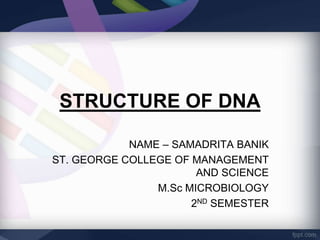
DNA Structure & Replication Explained in 40 Steps
- 1. STRUCTURE OF DNA NAME – SAMADRITA BANIK ST. GEORGE COLLEGE OF MANAGEMENT AND SCIENCE M.Sc MICROBIOLOGY 2ND SEMESTER
- 2. INTRODUCTION DNA is made up of molecules called nucleotides. Each nucleotide contains a phosphate group, a sugar group and a nitrogen base. The four types of nitrogen bases are adenine (A), thymine (T), guanine (G) and cytosine (C). The order of these bases is what determines DNA's instructions, or genetic code.
- 3. DNA
- 4. DNA STRUCTURE DNA is a nucleic acid, one of the four major groups of biological macromolecules. • Nucleotides All nucleic acids are made up of nucleotides. In DNA, each nucleotide is made up of three parts: a 5-carbon sugar called deoxyribose, a phosphate group, and a nitrogenous base. DNA uses four kinds of nitrogenous bases: adenine (A), guanine (G) cytosine (C), and thymine (T). RNA nucleotides may also contain adenine, guanine and cytosine bases, but instead of thymine they have another base called uracil (U).
- 5. • Chargaff's rules In the 1950s, a biochemist named Erwin Chargaff discovered that the amounts of the nitrogenous bases (A, T, C, and G) were not found in equal quantities. However, the amount of A always equalled the amount of T, and the amount of C always equalled the amount of G. These findings turned out to be crucial to uncovering the model of the DNA double helix.
- 6. • Double helix The discovery of the double helix structure of DNA was made thanks to a number of scientists in the 1950s. DNA molecules have an antiparallel structure - that is, the two strands of the helix run in opposite directions of one another. Each strand has a 5' end and a 3' end. Solving the structure of DNA was one of the great scientific achievements of the century. Knowing the structure of DNA unlocked the door to understanding many aspects of DNA's function, such as how it is copied and how the information it carries can be used to produce proteins.
- 8. DNA replication DNA replication is semi-conservative. This means that each of the two strands in double- stranded DNA acts as a template to produce two new strands. Replication relies on complementary base pairing, that is the principle explained by Chargaff's rules: adenine (A) always bonds with thymine (T) and cytosine (C) always bonds with guanine (G).
- 10. THE REPLICATION PROCESS DNA replication occurs through the help of several enzymes. These enzymes "unzip" DNA molecules by breaking the hydrogen bonds that hold the two strands together. Each strand then serves as a template for a new complementary strand to be created. Complementary bases attach to one another A-T and C. The primary enzyme involved in this is DNA polymerase which joins nucleotides to synthesize the new complementary strand. DNA polymerase also proofreads each new DNA strand to make sure that there are no errors.
- 11. Leading and lagging strands DNA is made differently on the two strands at a replication fork. One new strand, the leading strand, runs 5' to 3' towards the fork and is made continuously. The other, the lagging strand, runs 5' to 3' away from the fork and is made in small pieces called Okazaki fragments.
- 12. Common mistakes and misconceptions • DNA replication is not the same as cell division. Replication occurs before cell division, during the S phase of the cell cycle. However, replication only concerns the production of new DNA strands, not of new cells. • Some people think that in the leading strand, DNA is synthesized in the 5’ to 3’ direction, while in lagging strand, DNA is synthesized in the 3’ to 5’ direction. This is not the case. DNA polymerase only synthesizes DNA in the 5’ to 3’ direction only. The difference between the leading and lagging strands is that the leading strand is formed towards replication fork, while the lagging strand is formed away from replication fork.
- 13. CONCLUSION Each strand of a DNA molecule is composed of a long chain of monomer nucleotides. The nucleotides of DNA consist of a deoxyribose sugar molecule to which is attached a phosphate group and one of four nitrogenous bases: two purines (adenine and guanine) and two pyrimidines (cytosine and thymine). The nucleotides are joined together by covalent bonds between the phosphate of one nucleotide and the sugar of the next, forming a phosphate-sugar backbone from which the nitrogenous bases protrude. One strand is held to another by hydrogen bonds between the bases; the sequencing of this bonding is specific—i.e., adenine bonds only with thymine, and cytosine only with guanine.